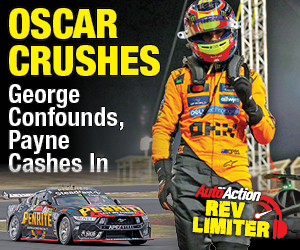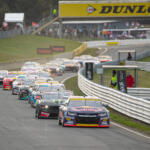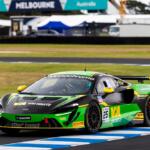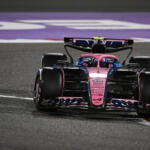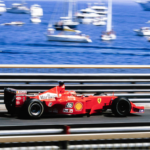Verstappen snatches Suzuka Pole in Honda send-off
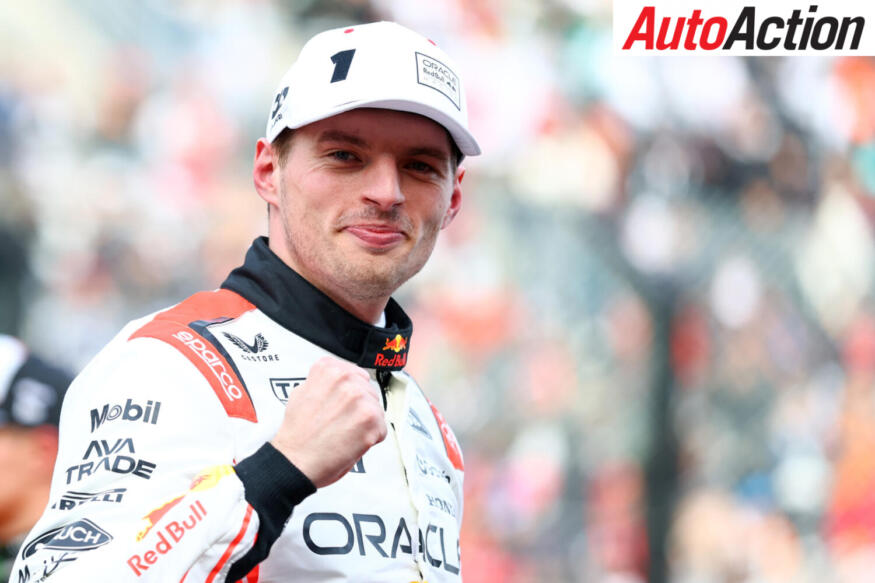
By Reese Mautone
Date posted: 5 April 2025
Shocking not only McLaren but himself as well, Max Verstappen put a near-perfect lap together to snatch Pole Position from Lando Norris — the perfect tribute to mark the final Japanese Grand Prix of the Red Bull-Honda era.
Qualifying 1:
Lining up at the end of the pitlane, the drivers were unleashed onto the iconic Suzuka International Circuit to kick off an exciting hour of qualifying contest.
Tasked with weaving his way through the out-lap traffic, Jack Doohan was one of the first drivers to launch during Q1.
He set a time of 1:29.803s, a lap that ultimately left him at the very bottom of the order once the entire grid’s initial runs were completed.
The Australian set a personal best sector to open his final lap, flying by the scene of his brutal FP3 crash before failing to improve in the middle sector and becoming one of many drivers to lose out.
As a result, Doohan couldn’t boost himself beyond the bottom five, leaving himself with a difficult task on Sunday as he looks to launch from P19.
Both Racing Bulls took a cautious approach at the start of Q1, remaining in the garage for an additional seven minutes before putting a time on the board.
When Liam Lawson eventually rounded the final turn, he put his VCARB 02 into ninth place, however, running out of sync with the rest of the field, the Kiwi was forced to settle for an at-risk P16.
Needing to improve on his last Q1 attempt, Lawson was one of the last drivers to launch, making it a nervous wait in the RB garage before he managed to just scrape through in a risky P15.
Setting the early Q1 benchmark, Lando Norris picked up where he left off in FP3 as he collected fastest sectors across the entire lap before his teammate outpaced him.
Not quite able to match his teammate in the primary stages of the lap, Oscar Piastri recovered through the middle and final sectors to record a time of 1:27.687s, boosting him into P1 ahead of his teammate.
The Australian gradually dropped down to P3, however, on his final attempt, reclaimed the fastest time of the 18-minute session.
Splitting the McLaren duo early on, George Russell impressed on his initial flying lap as he fell just 58 milliseconds short of the top time.
On the field’s second attempt, Norris reclaimed P1, however, this time with the Ferrari of Charles Leclerc perching himself in between the papaya cars.
In the elimination zone, Isack Hadjar was having a nightmare start to his session, with his presumed seatbelt complications from FP3 carrying over to Q1.
As a result, the RB driver was called back into his garage for a lap-belt adjustment, apologising to his team after admitting the discomfort issue was causing him to lose focus and time on track.
Lawson, Fernando Alonso, Kimi Antonelli and Lance Stroll were also circulating as the drivers at risk, with all barring the #18 launching for their last-ditch attempts and successfully securing a place in Q2.
Replacing them in the knockout zone were the two Sauber cars who will start from P16 and P17, ahead of Esteban Ocon, Doohan and Stroll.
Qualifying 2:
Waiting patiently at the pit exit, Max Verstappen was the first driver out of the gates when the light went green to start Q2.
The on-track position didn’t translate onto the timing sheets for the Dutchman, with Lando Norris lighting up the circuit with three purple sectors.
His time of 1:27.146s sat over three-tenths in the clear, while Piastri, running on fresh soft tyres made an error at the second Degner which left the Australian in P4.
Alex Albon impressed by setting the fifth fastest time, excelling through Turn 11 to aid the Williams driver in outpacing both Ferraris.
Looking to recover, the Ferrari duo were looking to recover when the sixth Red Flag of the weekend hit, brought on by yet another grass fire at Suzuka.
The session restarted with eight minutes on the clock, with Carlos Sainz, Alonso, Ollie Bearman, Yuki Tsunoda and Lawson as the drivers in the elimination zone.
The Ferrari duo were the only cars to leave the pitlane when the light went green, hoping to improve from a risky P6 and P7.
The opening sector was poor for Lewis Hamilton who had a snap of oversteer and a slow-moving Sainz in his way, with his teammate also declaring his S1 “rubbish” as they teammates slotted into P4 and P5.
With five minutes remaining, the rest of the field made their way out on track, with the home hero included.
The opening sector was a letdown for Tsunoda thanks to overcorrections at Turn 2, and despite setting two personal best sectors to round out the 5.8km lap, it wasn’t enough to advance to the top ten shootout.
What originally was P11 soon became P15 for the newly promoted Red Bull driver, with Lawson celebrating the mini victory of out-qualifying Tsunoda by 0.094s.
The two topical drivers will line up alongside one another to start the Japanese Grand Prix, with the former teammates now forced to tussle for position into the high-speed first corner.
Both drivers’ current teammates managed to make it through to the top ten shootout, with Isack Hadjar just scraping through alongside fellow rookies Bearman and Antonelli.
Not sharing the same luck, Pierre Gasly was knocked out in P11, ahead of Sainz who remains under investigation for impeding Hamilton, and Alonso.
Qualifying 3:
Ready to take on his first Q3 session of the season, Bearman sat alone at the pit exit before leading the final charge on track.
He was the first to launch around the lap, setting a solid lap by Haas’ standards, however, falling short of the top four teams as they completed their banker laps.
Putting his best foot forward on his mission to secure his second-ever Pole Position, Piastri secured the provisional top spot with a time of 1:27.052s.
The top four was made up of four different constructors, with Max Verstappen being the closest threat for Pole, however, still at a two-tenth deficit.
In third, Leclerc looked uneasy, and that proved to be the case for both Ferrari drivers when they launched for their final attempts.
Already sitting at the back end of the order, Hamilton made a costly error in the middle sector that left him four-tenths down and condemned to start tomorrow’s 53-lap race from P8, ahead of only Albon and Bearman.
The seven-time world champion will share the fourth row with a driver who made his admiration for Hamilton no secret.
Hadjar lapped less than a tenth faster than the Ferrari despite his seatbelt issues, qualifying behind a double Mercedes-filled Row 3.
As for the first two rows, Piastri counted himself out when he made an error at Turn 2, losing time while his teammate set purple sectors across the lap.
Norris originally slotted into provisional Pole, however, the shock of the session soon arrived when Max Verstappen stunned Honda’s home crowd by stealing Pole Position from McLaren.
With a new track record of 1:26.983s, Verstappen was just 12 milliseconds ahead of Norris, with Piastri only 44 milliseconds behind in third.
Leclerc rounded out the second row, hoping to hold position into Turn 1 when the fast-charging Mercedes of George Russell forges his attack tomorrow afternoon.
Lights out for the potentially wet Japanese Grand Prix will take place at 15:00 AEST on Sunday, with Verstappen aiming to covert Pole into victory for Red Bull’s last home race with Honda.
Image: Mark Thompson/Getty Images // Getty Images / Red Bull Content Pool
Japanese Grand Prix Qualifying Results:
|
POS
|
NO
|
DRIVER
|
CAR
|
Q1
|
Q2
|
Q3
|
LAPS
|
|
1
|
1
|
Verstappen
|
Red Bull Racing Honda RBPT
|
1:27.943
|
1:27.502
|
1:26.983
|
17
|
|
2
|
4
|
Norris
|
McLaren Mercedes
|
1:27.845
|
1:27.146
|
1:26.995
|
15
|
|
3
|
81
|
Piastri
|
McLaren Mercedes
|
1:27.687
|
1:27.507
|
1:27.027
|
18
|
|
4
|
16
|
Leclerc
|
Ferrari
|
1:27.920
|
1:27.555
|
1:27.299
|
21
|
|
5
|
63
|
Russell
|
Mercedes
|
1:27.843
|
1:27.400
|
1:27.318
|
17
|
|
6
|
12
|
Antonelli
|
Mercedes
|
1:27.968
|
1:27.639
|
1:27.555
|
18
|
|
7
|
6
|
Hadjar
|
Racing Bulls Honda RBPT
|
1:28.278
|
1:27.775
|
1:27.569
|
18
|
|
8
|
44
|
Hamilton
|
Ferrari
|
1:27.942
|
1:27.610
|
1:27.610
|
23
|
|
9
|
23
|
Albon
|
Williams Mercedes
|
1:28.218
|
1:27.783
|
1:27.615
|
20
|
|
10
|
87
|
Bearman
|
Haas Ferrari
|
1:28.228
|
1:27.711
|
1:27.867
|
21
|
|
11
|
10
|
Gasly
|
Alpine Renault
|
1:28.186
|
1:27.822
|
|
12
|
|
12
|
55
|
Sainz
|
Williams Mercedes
|
1:28.209
|
1:27.836
|
|
15
|
|
13
|
14
|
Alonso
|
Aston Martin Aramco Mercedes
|
1:28.337
|
1:27.897
|
|
12
|
|
14
|
30
|
Lawson
|
Racing Bulls Honda RBPT
|
1:28.554
|
1:27.906
|
|
12
|
|
15
|
22
|
Tsunoda
|
Red Bull Racing Honda RBPT
|
1:27.967
|
1:28.000
|
|
12
|
|
16
|
27
|
Hulkenberg
|
Kick Sauber Ferrari
|
1:28.570
|
|
|
9
|
|
17
|
5
|
Bortoleto
|
Kick Sauber Ferrari
|
1:28.622
|
|
|
9
|
|
18
|
31
|
Ocon
|
Haas Ferrari
|
1:28.696
|
|
|
9
|
|
19
|
7
|
Doohan
|
Alpine Renault
|
1:28.877
|
|
|
9
|
|
20
|
18
|
Stroll
|
Aston Martin Aramco Mercedes
|
1:29.271
|
|
|
5
|
Read the new issue of Auto Action Digital HERE
Don’t forget the print edition of Auto Action available via subscription here or you can purchase a copy of the latest issue from one of our outlets here. For more of the latest motorsport news, subscribe to AUTO ACTION magazine.
Recent Stories
array (
0 =>
WP_Term::__set_state(array(
'term_id' => 37,
'name' => 'F1',
'slug' => 'f1',
'term_group' => 0,
'term_taxonomy_id' => 37,
'taxonomy' => 'category',
'description' => 'An Introduction to Formula One (F1)
Formula One, or F1, is the highest class of single-seater auto racing, governed by the Fédération Internationale de l\'Automobile (FIA) and is owned by Liberty Media. The name "Formula One" refers to the set of rules or formula that all cars and drivers must comply with.
The F1 season consists of a series of races, known as Grands Prix, held on purpose-built circuits or public roads around the world. The results of each race are combined to determine two annual championships: one for drivers and one for constructors (teams).
The history of Formula One can be traced back to the pre-war Grand Prix racing, which featured open-wheel cars with supercharged engines. The first World Championship of Drivers was organised by the FIA in 1950, following the end of World War II. The first race was held at Silverstone, England, and was won by Giuseppe Farina, driving an Alfa Romeo. The first constructors\' championship was introduced in 1958 and was won by Vanwall.
Formula One has seen many changes and innovations over the years, both in terms of technology and regulations. Some of the most notable developments include the introduction of rear-engined cars in the late 1950s, the use of aerodynamic wings in the late 1960s, the adoption of turbocharged engines in the late 1970s, the emergence of electronic driver aids in the late 1980s, the switch to V10 and then V8 engines in the 1990s and 2000s, and the introduction of hybrid power units in 2014.
Formula One has also produced some of the greatest drivers and rivalries in the history of motorsport. Some of the most famous names include Juan Manuel Fangio, Jim Clark, Jackie Stewart, Niki Lauda, Ayrton Senna, Alain Prost, Michael Schumacher, Lewis Hamilton, and Sebastian Vettel. Some of the most intense battles for the championship have been between Fangio and Stirling Moss in the 1950s, Lauda and James Hunt in the 1970s, Senna and Prost in the late 1980s, Schumacher and Mika Hakkinen in the late 1990s, and Hamilton and Vettel in the 2010s.
Formula One is widely regarded as the pinnacle of motorsport, attracting millions of fans and viewers worldwide. The sport is also a huge business, involving billions of dollars in revenue and expenditure. The teams compete for prize money, sponsorship deals, and media rights, while the drivers earn millions of dollars in salaries and endorsements. The sport is also influenced by politics, regulations, and controversies, such as doping scandals, espionage cases, safety issues, and environmental concerns.
The following is a list of all F1 World Drivers Champions by year, from 1950 to 2020:
1950-1959
1950: Giuseppe Farina (Italy) - Alfa Romeo 158, Alfa Romeo
1951: Juan Manuel Fangio (Argentina) - Alfa Romeo 159, Alfa Romeo
1952: Alberto Ascari (Italy) - Ferrari 500, Ferrari
1953: Alberto Ascari (Italy) - Ferrari 500, Ferrari
1954: Juan Manuel Fangio (Argentina) - Maserati 250F, Maserati / Mercedes-Benz W196, Mercedes-Benz
1955: Juan Manuel Fangio (Argentina) - Mercedes-Benz W196, Mercedes-Benz
1956: Juan Manuel Fangio (Argentina) - Ferrari D50, Ferrari
1957: Juan Manuel Fangio (Argentina) - Maserati 250F, Maserati
1958: Mike Hawthorn (United Kingdom) - Ferrari 246, Ferrari
1959: Jack Brabham (Australia) - Cooper T51, Cooper-Climax
1960-1969
1960: Jack Brabham (Australia) - Cooper T53, Cooper-Climax
1961: Phil Hill (United States) - Ferrari 156, Ferrari
1962: Graham Hill (United Kingdom) - BRM P57, BRM
1963: Jim Clark (United Kingdom) - Lotus 25, Lotus-Climax
1964: John Surtees (United Kingdom) - Ferrari 158, Ferrari
1965: Jim Clark (United Kingdom) - Lotus 33, Lotus-Climax
1966: Jack Brabham (Australia) - Brabham BT19, Brabham-Repco
1967: Denny Hulme (New Zealand) - Brabham BT20, Brabham-Repco
1968: Graham Hill (United Kingdom) - Lotus 49, Lotus-Ford
1969: Jackie Stewart (United Kingdom) - Matra MS80, Matra-Ford
1970-1979
1970: Jochen Rindt (Austria) - Lotus 72, Lotus-Ford
1971: Jackie Stewart (United Kingdom) - Tyrrell 003, Tyrrell-Ford
1972: Emerson Fittipaldi (Brazil) - Lotus 72D, Lotus-Ford
1973: Jackie Stewart (United Kingdom) - Tyrrell 006, Tyrrell-Ford
1974: Emerson Fittipaldi (Brazil) - McLaren M23, McLaren-Ford
1975: Niki Lauda (Austria) - Ferrari 312T, Ferrari
1976: James Hunt (United Kingdom) - McLaren M23, McLaren-Ford
1977: Niki Lauda (Austria) - Ferrari 312T2, Ferrari
1978: Mario Andretti (United States) - Lotus 79, Lotus-Ford
1979: Jody Scheckter (South Africa) - Ferrari 312T4, Ferrari
1980-1989
1980: Alan Jones (Australia) - Williams FW07B, Williams-Ford
1981: Nelson Piquet (Brazil) - Brabham BT49C, Brabham-Ford
1982: Keke Rosberg (Finland) - Williams FW08, Williams-Ford
1983: Nelson Piquet (Brazil) - Brabham BT52, Brabham-BMW
1984: Niki Lauda (Austria) - McLaren MP4/2, McLaren-TAG
1985: Alain Prost (France) - McLaren MP4/2B, McLaren-TAG
1986: Alain Prost (France) - McLaren MP4/2C, McLaren-TAG
1987: Nelson Piquet (Brazil) - Williams FW11B, Williams-Honda
1988: Ayrton Senna (Brazil) - McLaren MP4/4, McLaren-Honda
1989: Alain Prost (France) - McLaren MP4/5, McLaren-Honda
1990-1999
1990: Ayrton Senna (Brazil) - McLaren MP4/5B, McLaren-Honda
1991: Ayrton Senna (Brazil) - McLaren MP4/6, McLaren-Honda
1992: Nigel Mansell (United Kingdom) - Williams FW14B, Williams-Renault
1993: Alain Prost (France) - Williams FW15C, Williams-Renault
1994: Michael Schumacher (Germany) - Benetton B194, Benetton-Ford
1995: Michael Schumacher (Germany) - Benetton B195, Benetton-Renault
1996: Damon Hill (United Kingdom) - Williams FW18, Williams-Renault
1997: Jacques Villeneuve (Canada) - Williams FW19, Williams-Renault
1998: Mika Häkkinen (Finland) - McLaren MP4/13, McLaren-Mercedes
1999: Mika Häkkinen (Finland) - McLaren MP4/14, McLaren-Mercedes
2000-2009
2000: Michael Schumacher (Germany) - Ferrari F1-2000, Ferrari
2001: Michael Schumacher (Germany) - Ferrari F2001, Ferrari
2002: Michael Schumacher (Germany) - Ferrari F2002, Ferrari
2003: Michael Schumacher (Germany) - Ferrari F2003-GA, Ferrari
2004: Michael Schumacher (Germany) - Ferrari F2004, Ferrari
2005: Fernando Alonso (Spain) - Renault R25, Renault
2006: Fernando Alonso (Spain) - Renault R26, Renault
2007: Kimi Räikkönen (Finland) - Ferrari F2007, Ferrari
2008: Lewis Hamilton (United Kingdom) - McLaren MP4-23, McLaren-Mercedes
2009: Jenson Button (United Kingdom) - Brawn BGP 001, Brawn-Mercedes
2010-2020
2010: Sebastian Vettel (Germany) - Red Bull RB6, Red Bull-Renault
2011: Sebastian Vettel (Germany) - Red Bull RB7, Red Bull-Renault
2012: Sebastian Vettel (Germany) - Red Bull RB8, Red Bull-Renault
2013: Sebastian Vettel (Germany) - Red Bull RB9, Red Bull-Renault
2014: Lewis Hamilton (United Kingdom) - Mercedes F1 W05 Hybrid, Mercedes
2015: Lewis Hamilton (United Kingdom) - Mercedes F1 W06 Hybrid, Mercedes
2016: Nico Rosberg (Germany) - Mercedes F1 W07 Hybrid, Mercedes
2017: Lewis Hamilton (United Kingdom) - Mercedes F1 W08 EQ Power+, Mercedes
2018: Lewis Hamilton (United Kingdom) - Mercedes F1 W09 EQ Power+, Mercedes
2019: Lewis Hamilton (United Kingdom) - Mercedes F1 W10 EQ Power+, Mercedes
2020: Lewis Hamilton (United Kingdom) - Mercedes F1 W11 EQ Power+, Mercedes
2021-
2021: Max Verstappen (Netherlands) – Red Bull RB16B, Honda
2022: Max Verstappen (Netherlands) – Red Bull RB18, Red Bull Power Trains Honda
2023: Max Verstappen (Netherlands) – Red Bull RB19, Red Bull Power Trains Honda
2024: Max Verstappen (Netherlands) – Red Bull RB20, Red Bull Power Trains Honda',
'parent' => 660,
'count' => 2631,
'filter' => 'raw',
'cat_ID' => 37,
'category_count' => 2631,
'category_description' => 'An Introduction to Formula One (F1)
Formula One, or F1, is the highest class of single-seater auto racing, governed by the Fédération Internationale de l\'Automobile (FIA) and is owned by Liberty Media. The name "Formula One" refers to the set of rules or formula that all cars and drivers must comply with.
The F1 season consists of a series of races, known as Grands Prix, held on purpose-built circuits or public roads around the world. The results of each race are combined to determine two annual championships: one for drivers and one for constructors (teams).
The history of Formula One can be traced back to the pre-war Grand Prix racing, which featured open-wheel cars with supercharged engines. The first World Championship of Drivers was organised by the FIA in 1950, following the end of World War II. The first race was held at Silverstone, England, and was won by Giuseppe Farina, driving an Alfa Romeo. The first constructors\' championship was introduced in 1958 and was won by Vanwall.
Formula One has seen many changes and innovations over the years, both in terms of technology and regulations. Some of the most notable developments include the introduction of rear-engined cars in the late 1950s, the use of aerodynamic wings in the late 1960s, the adoption of turbocharged engines in the late 1970s, the emergence of electronic driver aids in the late 1980s, the switch to V10 and then V8 engines in the 1990s and 2000s, and the introduction of hybrid power units in 2014.
Formula One has also produced some of the greatest drivers and rivalries in the history of motorsport. Some of the most famous names include Juan Manuel Fangio, Jim Clark, Jackie Stewart, Niki Lauda, Ayrton Senna, Alain Prost, Michael Schumacher, Lewis Hamilton, and Sebastian Vettel. Some of the most intense battles for the championship have been between Fangio and Stirling Moss in the 1950s, Lauda and James Hunt in the 1970s, Senna and Prost in the late 1980s, Schumacher and Mika Hakkinen in the late 1990s, and Hamilton and Vettel in the 2010s.
Formula One is widely regarded as the pinnacle of motorsport, attracting millions of fans and viewers worldwide. The sport is also a huge business, involving billions of dollars in revenue and expenditure. The teams compete for prize money, sponsorship deals, and media rights, while the drivers earn millions of dollars in salaries and endorsements. The sport is also influenced by politics, regulations, and controversies, such as doping scandals, espionage cases, safety issues, and environmental concerns.
The following is a list of all F1 World Drivers Champions by year, from 1950 to 2020:
1950-1959
1950: Giuseppe Farina (Italy) - Alfa Romeo 158, Alfa Romeo
1951: Juan Manuel Fangio (Argentina) - Alfa Romeo 159, Alfa Romeo
1952: Alberto Ascari (Italy) - Ferrari 500, Ferrari
1953: Alberto Ascari (Italy) - Ferrari 500, Ferrari
1954: Juan Manuel Fangio (Argentina) - Maserati 250F, Maserati / Mercedes-Benz W196, Mercedes-Benz
1955: Juan Manuel Fangio (Argentina) - Mercedes-Benz W196, Mercedes-Benz
1956: Juan Manuel Fangio (Argentina) - Ferrari D50, Ferrari
1957: Juan Manuel Fangio (Argentina) - Maserati 250F, Maserati
1958: Mike Hawthorn (United Kingdom) - Ferrari 246, Ferrari
1959: Jack Brabham (Australia) - Cooper T51, Cooper-Climax
1960-1969
1960: Jack Brabham (Australia) - Cooper T53, Cooper-Climax
1961: Phil Hill (United States) - Ferrari 156, Ferrari
1962: Graham Hill (United Kingdom) - BRM P57, BRM
1963: Jim Clark (United Kingdom) - Lotus 25, Lotus-Climax
1964: John Surtees (United Kingdom) - Ferrari 158, Ferrari
1965: Jim Clark (United Kingdom) - Lotus 33, Lotus-Climax
1966: Jack Brabham (Australia) - Brabham BT19, Brabham-Repco
1967: Denny Hulme (New Zealand) - Brabham BT20, Brabham-Repco
1968: Graham Hill (United Kingdom) - Lotus 49, Lotus-Ford
1969: Jackie Stewart (United Kingdom) - Matra MS80, Matra-Ford
1970-1979
1970: Jochen Rindt (Austria) - Lotus 72, Lotus-Ford
1971: Jackie Stewart (United Kingdom) - Tyrrell 003, Tyrrell-Ford
1972: Emerson Fittipaldi (Brazil) - Lotus 72D, Lotus-Ford
1973: Jackie Stewart (United Kingdom) - Tyrrell 006, Tyrrell-Ford
1974: Emerson Fittipaldi (Brazil) - McLaren M23, McLaren-Ford
1975: Niki Lauda (Austria) - Ferrari 312T, Ferrari
1976: James Hunt (United Kingdom) - McLaren M23, McLaren-Ford
1977: Niki Lauda (Austria) - Ferrari 312T2, Ferrari
1978: Mario Andretti (United States) - Lotus 79, Lotus-Ford
1979: Jody Scheckter (South Africa) - Ferrari 312T4, Ferrari
1980-1989
1980: Alan Jones (Australia) - Williams FW07B, Williams-Ford
1981: Nelson Piquet (Brazil) - Brabham BT49C, Brabham-Ford
1982: Keke Rosberg (Finland) - Williams FW08, Williams-Ford
1983: Nelson Piquet (Brazil) - Brabham BT52, Brabham-BMW
1984: Niki Lauda (Austria) - McLaren MP4/2, McLaren-TAG
1985: Alain Prost (France) - McLaren MP4/2B, McLaren-TAG
1986: Alain Prost (France) - McLaren MP4/2C, McLaren-TAG
1987: Nelson Piquet (Brazil) - Williams FW11B, Williams-Honda
1988: Ayrton Senna (Brazil) - McLaren MP4/4, McLaren-Honda
1989: Alain Prost (France) - McLaren MP4/5, McLaren-Honda
1990-1999
1990: Ayrton Senna (Brazil) - McLaren MP4/5B, McLaren-Honda
1991: Ayrton Senna (Brazil) - McLaren MP4/6, McLaren-Honda
1992: Nigel Mansell (United Kingdom) - Williams FW14B, Williams-Renault
1993: Alain Prost (France) - Williams FW15C, Williams-Renault
1994: Michael Schumacher (Germany) - Benetton B194, Benetton-Ford
1995: Michael Schumacher (Germany) - Benetton B195, Benetton-Renault
1996: Damon Hill (United Kingdom) - Williams FW18, Williams-Renault
1997: Jacques Villeneuve (Canada) - Williams FW19, Williams-Renault
1998: Mika Häkkinen (Finland) - McLaren MP4/13, McLaren-Mercedes
1999: Mika Häkkinen (Finland) - McLaren MP4/14, McLaren-Mercedes
2000-2009
2000: Michael Schumacher (Germany) - Ferrari F1-2000, Ferrari
2001: Michael Schumacher (Germany) - Ferrari F2001, Ferrari
2002: Michael Schumacher (Germany) - Ferrari F2002, Ferrari
2003: Michael Schumacher (Germany) - Ferrari F2003-GA, Ferrari
2004: Michael Schumacher (Germany) - Ferrari F2004, Ferrari
2005: Fernando Alonso (Spain) - Renault R25, Renault
2006: Fernando Alonso (Spain) - Renault R26, Renault
2007: Kimi Räikkönen (Finland) - Ferrari F2007, Ferrari
2008: Lewis Hamilton (United Kingdom) - McLaren MP4-23, McLaren-Mercedes
2009: Jenson Button (United Kingdom) - Brawn BGP 001, Brawn-Mercedes
2010-2020
2010: Sebastian Vettel (Germany) - Red Bull RB6, Red Bull-Renault
2011: Sebastian Vettel (Germany) - Red Bull RB7, Red Bull-Renault
2012: Sebastian Vettel (Germany) - Red Bull RB8, Red Bull-Renault
2013: Sebastian Vettel (Germany) - Red Bull RB9, Red Bull-Renault
2014: Lewis Hamilton (United Kingdom) - Mercedes F1 W05 Hybrid, Mercedes
2015: Lewis Hamilton (United Kingdom) - Mercedes F1 W06 Hybrid, Mercedes
2016: Nico Rosberg (Germany) - Mercedes F1 W07 Hybrid, Mercedes
2017: Lewis Hamilton (United Kingdom) - Mercedes F1 W08 EQ Power+, Mercedes
2018: Lewis Hamilton (United Kingdom) - Mercedes F1 W09 EQ Power+, Mercedes
2019: Lewis Hamilton (United Kingdom) - Mercedes F1 W10 EQ Power+, Mercedes
2020: Lewis Hamilton (United Kingdom) - Mercedes F1 W11 EQ Power+, Mercedes
2021-
2021: Max Verstappen (Netherlands) – Red Bull RB16B, Honda
2022: Max Verstappen (Netherlands) – Red Bull RB18, Red Bull Power Trains Honda
2023: Max Verstappen (Netherlands) – Red Bull RB19, Red Bull Power Trains Honda
2024: Max Verstappen (Netherlands) – Red Bull RB20, Red Bull Power Trains Honda',
'cat_name' => 'F1',
'category_nicename' => 'f1',
'category_parent' => 660,
)),
1 =>
WP_Term::__set_state(array(
'term_id' => 11,
'name' => 'Latest News',
'slug' => 'latest-news',
'term_group' => 0,
'term_taxonomy_id' => 11,
'taxonomy' => 'category',
'description' => '',
'parent' => 0,
'count' => 15853,
'filter' => 'raw',
'cat_ID' => 11,
'category_count' => 15853,
'category_description' => '',
'cat_name' => 'Latest News',
'category_nicename' => 'latest-news',
'category_parent' => 0,
)),
2 =>
WP_Term::__set_state(array(
'term_id' => 2029,
'name' => 'ZZZ-Email',
'slug' => 'email',
'term_group' => 0,
'term_taxonomy_id' => 2029,
'taxonomy' => 'category',
'description' => '',
'parent' => 2031,
'count' => 6425,
'filter' => 'raw',
'cat_ID' => 2029,
'category_count' => 6425,
'category_description' => '',
'cat_name' => 'ZZZ-Email',
'category_nicename' => 'email',
'category_parent' => 2031,
)),
3 =>
WP_Term::__set_state(array(
'term_id' => 2031,
'name' => 'ZZZ-RSSFeeds',
'slug' => 'zzz-rssfeeds',
'term_group' => 0,
'term_taxonomy_id' => 2031,
'taxonomy' => 'category',
'description' => '',
'parent' => 0,
'count' => 5779,
'filter' => 'raw',
'cat_ID' => 2031,
'category_count' => 5779,
'category_description' => '',
'cat_name' => 'ZZZ-RSSFeeds',
'category_nicename' => 'zzz-rssfeeds',
'category_parent' => 0,
)),
)
